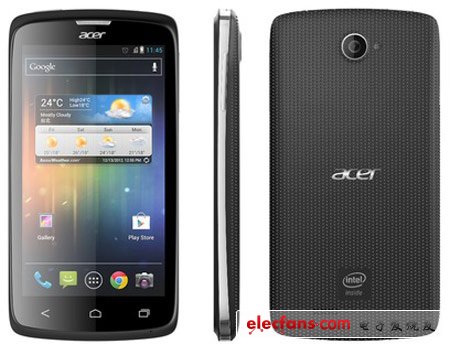On Thursday, Intel opened up a new battlefield, which belongs to the field of mobile processors, but Intel still has a long way to go. Intel and Acer cooperated in Bangkok to launch the Liquid C1 smartphone, priced at $ 300. It uses the Android operating system. The product was first launched in Thailand and then entered other Southeast Asian countries. Mike Bell, the head of Intel ’s mobile division, said in a telephone interview: “We consciously strive to catch up with these fast-growing markets and use it as our first step into this business.â€

This is the ninth product launched by Intel in 9 months. Liquid C1 can prove how far Intel has gone to persuade large manufacturers to adopt their own mobile chips. However, analysts pointed out that it also proves how far Intel has to gain a foothold in the market, which is dominated by Qualcomm and Nvidia.
Strategy AnalyTIcs chief analyst Bicheno (Scott Bicheno) said: "First of all they have to prove that they can play in this field, Intel's chips have no obvious technical problems, but the existing chip foundation is very stable."
In addition to entering the mobile market, Intel has few options. Last quarter, Intel's revenue fell 3% year-on-year, mainly due to weak PC sales. Since 2009, revenue growth has steadily declined. To this end, last year Intel introduced mobile phones using its own chips in Europe, Africa, Latin America, Russia, India and China.
The sales volume is not large, Intel refused to disclose the data, and ZTE and Lenovo also refused to disclose the data. However, according to IDC analyst Melissa Chau, in the third quarter of last year, Lenovo's best-selling mobile phone shipment in China exceeded 1 million units, but the first Intel mobile phone K800 shipped only 200,000 units.
history
For Intel, this is a historical issue. Intel admitted earlier that it was a step slower. Ten years ago, the industry was clearly shifting from desktop PCs and even laptops to smaller, lighter, connected devices with lower power consumption.
Last year, Intel seemed to shift its focus to mobile application processors. It acquired Infineon ’s wireless chip business and hired marketing experts like Bell.
Uday Marty, general manager of Intel Southeast Asia, said: "These people are mobile phone experts. They have really changed the way we enter the market and the way we design."
Analyst Bicheno said that it seems to be working, at least in terms of quality. Bicheno used the Motorola RAZR i phone, which uses Intel chips. Bicheno said that the phone's performance is as good as the Android phone.
Caroline Gabriel, head of research at Rethink Wireless, said: "After years of failure, they have learned a lot about the mobile world and learned more about the differences. In the past, Intel did not understand bringing the device to Carrier network processes, now they do. "
Intel has several coups. First of all, they have a long relationship with Acer, Lenovo and Asus. All these enterprises have a problem: as a PC vendor, they need to grow in mobile business. Even so, they enter the mobile business slowly. A Taiwanese industry source revealed that Intel threw a lot of "baits" to persuade companies to use its own mobile chips. Intel executives knew they had to bear some costs, but they did not buy PC manufacturers' production lines as deeply.
In addition, Intel also followed the strategy of optimizing Microsoft Windows, and worked closely with Google on Android to optimize software on the device.
Bell said: "We are not only investing in chips, we are also investing heavily in software that runs on chips."
The problem is still
However, the problem still exists. First, some analysts pointed out that Intel ’s low barrier to entry in the mobile field will make the company bear the image of a low-end mobile phone chip manufacturer. When competing with low-cost chip makers for high output and low gross profit margins, Intel will attract failed doom.
Intel countered that the reason it focused on the $ 200-500 mobile phone market is because it has a lot of room for growth, and it plans to eventually provide chips at various price points, just like PC chips.
Intel executives also said that 4G LTE chips will be launched later this year or early 2014. The United States is deploying 4G LTE networks and Europe will also launch them. But Rethink Wireless research director Caroline Gabriel pointed out that Intel will lag behind Qualcomm and STMicroelectronics.
Another question is whether Intel can jump out of the original partner circle. Analysts say that it is one thing for Intel to convince Acer and Lenovo to launch smartphones. It is another matter to convince smartphone vendors with solid status, such as HTC, Samsung and Apple; only by persuading them can the output be Only by upgrading can profits be considerable.
IHS analyst Francis Sideco pointed out: "Given Intel's huge resources, I will not easily overlook its ability to enter any target market."
Mike Bell, director of Intel ’s mobile division, said that BlackBerry and Nokia fell rapidly, and Samsung and Apple rose rapidly, suggesting that Intel is only a small player now, but may not always be.
Bell said: "A few years ago, I was developing mobile phones in different companies. At that time, there was a company that dominated the earth. It was RIM." Bell worked at Palm and Apple. What he means is that the share of BlackBerry has declined rapidly in the past few years. Bell said: "Try to see who is the leader after 2 years."
ALLIN , https://www.nbdisplayapio.com